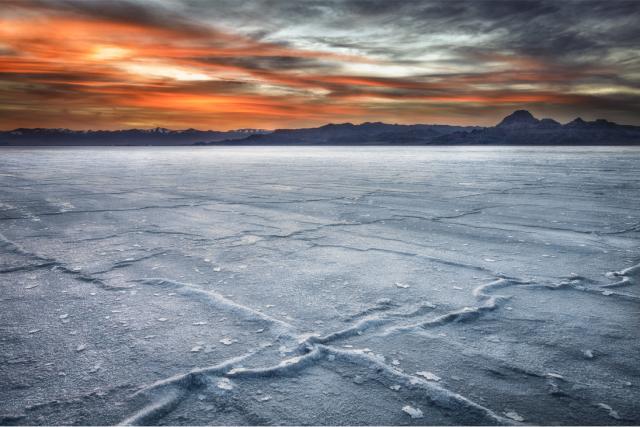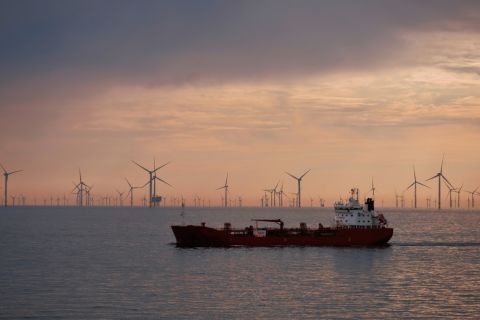
Bonneville Salt Flats in Utah (Source: Shutterstock.com)
A pioneering $1 billion project for large-scale storage of energy from wind and solar power has been launched in Utah, offering a way to manage the variability of renewable generation.
A consortium including Mitsubishi Hitachi Power Systems (MHPS) of Japan on May 30 announced a plan to use a huge salt cavern to store hydrogen or compressed air, which could be used to generate up to 1,000 megawatts (MW) of power.
The variable output of wind and solar power, both within a day and seasonally, is one of the principal obstacles impeding the rise of renewable energy, and cost-effective, large-scale storage using hydrogen or compressed air would be a significant breakthrough for the industry.
The Utah project, known as Advanced Clean Energy Storage, is intended to serve customers on the west coast of the US and in Nevada that have growing shares of renewable power generation, storing energy when electricity prices are very low or negative, and then releasing it when supplies are tighter and prices rise. The consortium partners aim to have it in operation in 2025, with an initial output of 250 MW, rising to 1,000 MW later.
Paul Browning, CEO in the Americas for MHPS, which is a joint venture between Mitsubishi Heavy Industries and Hitachi, said the project would be the world’s largest energy storage facility designed to manage the variability of renewable power sources.
“We’re doing something that’s of foundational importance,” he said. “We’ve still got work to do, but we’re really excited.”
The consortium is aiming to deliver power at a cost that is the same as, or lower than, the lithium-ion battery storage units that are now starting to be deployed to help manage variations in electricity supply and demand in many markets.
Those battery systems are limited to a maximum storage capacity of a few hours, however, meaning they are useful only for managing intraday variations. Storage using hydrogen or compressed air can last indefinitely, meaning that it can be used to cover seasonal downturns in wind or solar generation.
The size of the Utah cavern, which is about one mile deep and three miles across, meant the storage capacity of the site was effectively unlimited, Browning said.
Market conditions in areas with rising shares of renewable generation on the grid have created favorable conditions for energy storage. At times when power supplies are high, in the middle of the day for solar or often at night for wind, and demand is relatively low, electricity prices can drop below zero, and some generators can be forced to shut off their output. The economics of the ACES plant will depend on using that no-cost electricity to fill its storage facility.
The consortium has not yet decided whether to use hydrogen or compressed air or some combination of the two. Using hydrogen would mean taking free electricity from the grid and using it to electrolyze water. The hydrogen would be injected into the facility and then released to burn in a gas turbine to generate power as needed.
The air version would similarly use free power for compression, then use the air to turn a turbine as needed.
The choice between the two does not need to be made immediately because the first step is preparing the cavern, which will take up to two years, and MHPS will meanwhile work on developing the most cost-effective generation technology. The site is also intended to have batteries and fuel cells to provide some shorter-term storage and quick-start power.
Although the ACES plant could make a useful contribution to power markets in California and other western states, the unusual geology of the site means it will not be easily replicated elsewhere.
The project consortium, which also includes a company called Magnum Development that owns the site and has been developing other caverns to store liquid fuels, says it is the only site in the western U.S. that could be used for energy storage in this way.
Recommended Reading
Commentary: Are Renewable Incentives Degrading Powergen Reliability?
2024-02-01 - A Vistra Corp. chief, ERCOT’s vice chairman and a private investor talk about what’s really happening on the U.S. grid, and it’s not just a Texas thing.
Veriten’s Arjun Murti: Oil, Gas Prospectors Need to Step Up—Again
2024-02-08 - Arjun Murti, a partner in investment and advisory firm Veriten, says U.S. shale provided 90% of global supply growth—but the industry needs to reinvent itself, again.
Heard from the Field: US Needs More Gas Storage
2024-03-21 - The current gas working capacity fits a 60 Bcf/d market — but today, the market exceeds 100 Bcf/d, gas executives said at CERAWeek by S&P Global.
Exclusive: Renewables Won't Promise Affordable Security without NatGas
2024-03-25 - Greg Ebel, president and CEO of midstream company Enbridge, says renewables needs backing from natural gas to create a "nice foundation" for affordable and sustainable industrial growth, in this Hart Energy Exclusive interview.
Exclusive: Chevron Balancing Low Carbon Intensity, Global Oil, Gas Needs
2024-03-28 - Colin Parfitt, president of midstream at Chevron, discusses how the company continues to grow its traditional oil and gas business while focusing on growing its new energies production, in this Hart Energy Exclusive interview.





